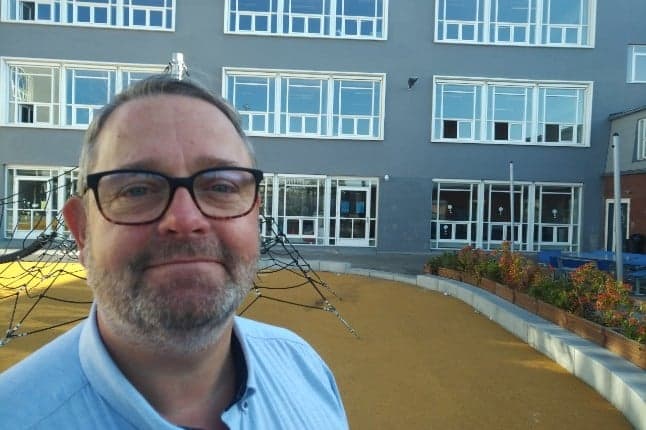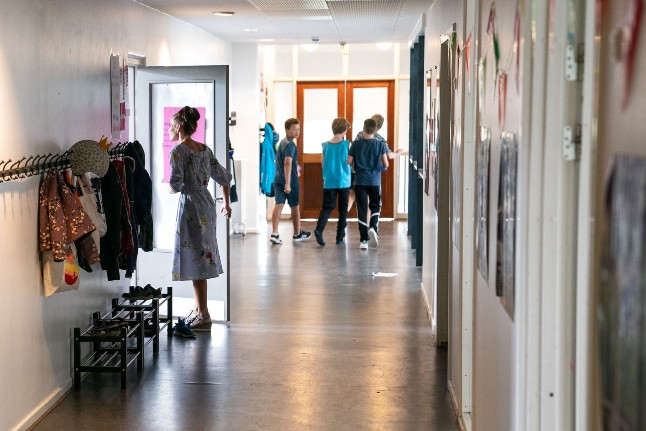How one school in Denmark prepared for the return of older pupils

Headteacher Søren Friis picks up a chair in one of the classrooms in Lykkebo Skole and repositions it at the narrow end of one of the desks.
"They would have been like this, and now it's like this. So, it's 1m 20," he grins. "They can't work here and they can then do this (he swivels the chair), and look at the teacher."
This is the main change that is happening as children over the age of 11 return to Lykkebo Skole, the school he runs in a quiet suburb of Copenhagen, on Monday morning, meaning almost all the school's roughly 500 pupils will be back.
The pupils, who have had a double desk to themselves since schools reopened on April 15, are now going back to sharing, but with each child occupying the narrow end.
"On Monday, they will have to sit there and then, almost, we will have a normal school day," he tells The Local when we visit during the preparations for opening for year's six to ten.
"The problem for the students will that be they can't interact and same way: they can't fight and do these things and they love to do. They still have to keep a distance from each other."
 Pupils at Katrinedals School in Copenhagen in pre-Coronavirus times. Photo: Niels Christian Vilmann/Ritzau Scanpix
Pupils between the ages of 12 and 16 are returning to school (folkeskole) on Monday May 18, a process that has been made easier by halving the recommended distance that should be kept between people from 2m to 1m.
The return of older pupils also means that this classroom, which has had only had ten pupils in it, now goes back to about 25.
Friis says he is expecting his staff to have to do a lot of work to help the 12-16 year-olds catch up.
"If you look at the children and their mentally wellness, I think it's been hard. I think we got a lot of work to do when they come back," he says.
Dorte Lange, the vice-president of the Danish Union of Teachers, says that her union is currently talking to the Danish Ministry of Education about how her members could best help those who have fallen behind over the past two months of online tuition catch up.
"We're talking about how can we recover. Some students have actually had a lack of teaching in this period, because a lot of teaching has been done online and it's difficult to make sure that all kids are benefiting from it," she tells The Local. "So how can we in the best possible way catch up? How can the kids catch up?"
READ ALSO:
Pupils at Katrinedals School in Copenhagen in pre-Coronavirus times. Photo: Niels Christian Vilmann/Ritzau Scanpix
Pupils between the ages of 12 and 16 are returning to school (folkeskole) on Monday May 18, a process that has been made easier by halving the recommended distance that should be kept between people from 2m to 1m.
The return of older pupils also means that this classroom, which has had only had ten pupils in it, now goes back to about 25.
Friis says he is expecting his staff to have to do a lot of work to help the 12-16 year-olds catch up.
"If you look at the children and their mentally wellness, I think it's been hard. I think we got a lot of work to do when they come back," he says.
Dorte Lange, the vice-president of the Danish Union of Teachers, says that her union is currently talking to the Danish Ministry of Education about how her members could best help those who have fallen behind over the past two months of online tuition catch up.
"We're talking about how can we recover. Some students have actually had a lack of teaching in this period, because a lot of teaching has been done online and it's difficult to make sure that all kids are benefiting from it," she tells The Local. "So how can we in the best possible way catch up? How can the kids catch up?"
READ ALSO:
-
Outdoor classes with gym to stay warm: Denmark's reopened school
-
Denmark first in Europe to reopen schools after coronavirus lockdown
-
'I was crying in fear': How parents felt about Denmark's school reopening
Friis says that many of the pupils who returned on April 15 have benefitted from the smaller classes.
"Of course, every child does, because you have teachers can be more observant to each children all the time. When teachers only have to look after ten students, they can really look at 'how are they doing? When there's 25, it's a lot more."
Lange says her union is now pushing to try and retain some of the benefits of smaller classes in future.
"We can see now very clearly that smaller groups bring a higher degree of well-being for the kids, and give the teachers more contact with the kids during the day, so they can see where they have difficulties," she says.
"We are looking at whether we can continue that, and maybe shorten our school day a bit, with fewer lessons but with a higher degree of contact with students."
Comments
See Also
"They would have been like this, and now it's like this. So, it's 1m 20," he grins. "They can't work here and they can then do this (he swivels the chair), and look at the teacher."
This is the main change that is happening as children over the age of 11 return to Lykkebo Skole, the school he runs in a quiet suburb of Copenhagen, on Monday morning, meaning almost all the school's roughly 500 pupils will be back.
The pupils, who have had a double desk to themselves since schools reopened on April 15, are now going back to sharing, but with each child occupying the narrow end.
"On Monday, they will have to sit there and then, almost, we will have a normal school day," he tells The Local when we visit during the preparations for opening for year's six to ten.
"The problem for the students will that be they can't interact and same way: they can't fight and do these things and they love to do. They still have to keep a distance from each other."

Pupils at Katrinedals School in Copenhagen in pre-Coronavirus times. Photo: Niels Christian Vilmann/Ritzau Scanpix
Pupils between the ages of 12 and 16 are returning to school (folkeskole) on Monday May 18, a process that has been made easier by halving the recommended distance that should be kept between people from 2m to 1m.
The return of older pupils also means that this classroom, which has had only had ten pupils in it, now goes back to about 25.
Friis says he is expecting his staff to have to do a lot of work to help the 12-16 year-olds catch up.
"If you look at the children and their mentally wellness, I think it's been hard. I think we got a lot of work to do when they come back," he says.
Dorte Lange, the vice-president of the Danish Union of Teachers, says that her union is currently talking to the Danish Ministry of Education about how her members could best help those who have fallen behind over the past two months of online tuition catch up.
"We're talking about how can we recover. Some students have actually had a lack of teaching in this period, because a lot of teaching has been done online and it's difficult to make sure that all kids are benefiting from it," she tells The Local. "So how can we in the best possible way catch up? How can the kids catch up?"
READ ALSO:
- Outdoor classes with gym to stay warm: Denmark's reopened school
- Denmark first in Europe to reopen schools after coronavirus lockdown
- 'I was crying in fear': How parents felt about Denmark's school reopening
Friis says that many of the pupils who returned on April 15 have benefitted from the smaller classes.
"Of course, every child does, because you have teachers can be more observant to each children all the time. When teachers only have to look after ten students, they can really look at 'how are they doing? When there's 25, it's a lot more."
Lange says her union is now pushing to try and retain some of the benefits of smaller classes in future.
"We can see now very clearly that smaller groups bring a higher degree of well-being for the kids, and give the teachers more contact with the kids during the day, so they can see where they have difficulties," she says.
"We are looking at whether we can continue that, and maybe shorten our school day a bit, with fewer lessons but with a higher degree of contact with students."
Join the conversation in our comments section below. Share your own views and experience and if you have a question or suggestion for our journalists then email us at [email protected].
Please keep comments civil, constructive and on topic – and make sure to read our terms of use before getting involved.
Please log in here to leave a comment.